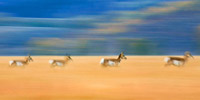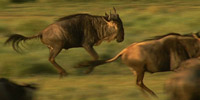Sudan Kob
Animals — White-Eared Kob
INTERACTIVE WHITE-EARED KOB PROFILE
WHITE-EARED KOB (Kobus kob)
The kob is a member of the genus Kobus, which also includes other grass-eating African antelopes such as the puku, the waterbuck, the lechwe and the Nile lechwe. Kob eat short grass, and are dependent upon hartebeest, hippos and other grazing animals to clear grazing areas for them. Many feared that the kob and other animals might have been decimated by a 25-year-long, brutal civil war in Sudan in the last part of the 20th century, which killed more than two million people and created the sort of chaos that often provides cover for poachers to destroy wildlife populations. But amazingly, a 2007 aerial survey by National Geographic scientist Michael Fay revealed that vast herds of kob and other animals still were flourishing in Sudan.
Kob migrate in search of fresh grazing lands and water, but their mobile lifestyle also enabled them to survive the carnage of 1983-2005 Sudanese civil war, which killed off vast numbers of less mobile species. They form part of a seasonal Sudanese migration that is similar in scale, and perhaps even bigger, than the trek of Wildebeests and zebras from the Serengeti. Kob, along with mongalla gazelles and tiang antelopes, form vast, densely packed columns of animals 30 miles across and 50 miles long. Along the way, they are vulnerable to lions and other natural predators, and also to human poachers, who hunt kob with nets, bows and arrows, and hunting dogs for their meat and horns.
Along with other ungulates, or grazing animals, the kob is an integral part of the process by which the savannas regenerate themselves. The animals’ excrement is buried by dung beetles, re-fertilizing the soil and increasing the protein and mineral content of the grasses. That, in turn, nourishes the herds when they eventually eat that vegetation, completing the cycle.
MORE MIGRATIONS
-
Preserve their HabitatHelp conserve the natural landscapes of these migratory species.
-
Teacher ResourcesJoin the virtual assembly and access lesson plans specific to your area.
-
Nat Geo ExpeditionsTake a migration of your own with National Geographic Explorers.
-
Science Behind MigrationsHow do animals decide where to go, how long to stay, and when to leave?















